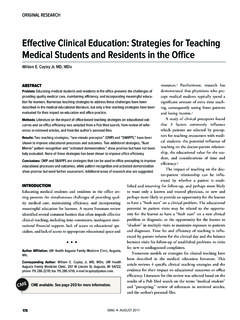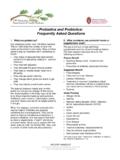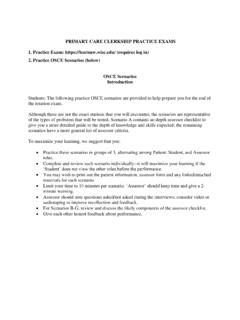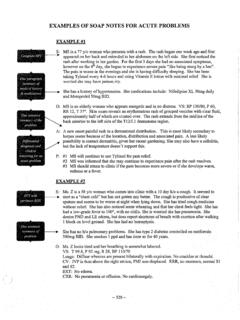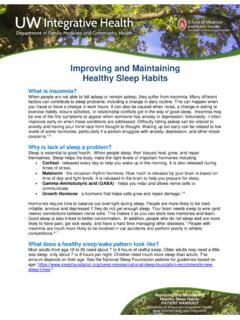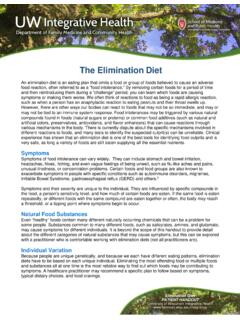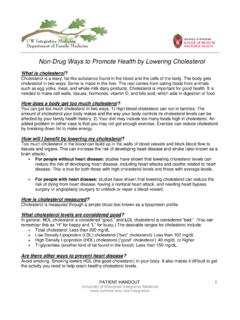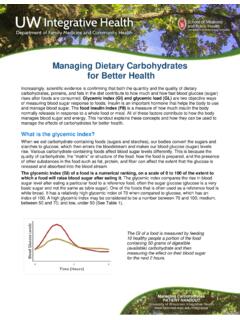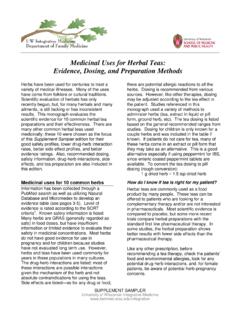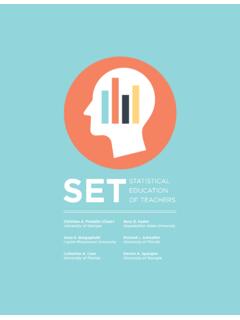Transcription of Creating a Gratitude Practice
1 Creating a Gratitude Practice PATIENT HANDOUT University of Wisconsin Integrative Health Create a Gratitude Practice What is Gratitude ? Gratitude means feeling thankful or being willing to show appreciation. Why is being grateful important for my health? Gratitude can improve your health in many ways. Physically, Gratitude can improve your energy levels and help you sleep It can also help you get better faster when you are Practicing Gratitude can improve your mood by decreasing your chances of having depression, anxiety, and substance abuse It can also improve the way you feel about your People who are grateful feel more happiness, pride, and They also feel more connected to Another reason to add Gratitude to your health plan is that you can do it for free! What is a Gratitude Practice ?
2 In order to experience the health benefits of Gratitude , it s important to have a routine Gratitude Practice . Gratitude practices are generally easy to do. The hard part is getting yourself to do them regularly, especially if you don t feel well. There are many different Gratitude practices . They can be as simple as dedicating time each day to reflect on what you are grateful for in your life. You can write down the people, things, events, interactions, and experiences you are grateful for. Or, you can think of ways to show others your Gratitude . Be creative. What if I struggle to think of things I am grateful for? When you consider what you are grateful for, don t forget the little things that make you happy or give you a sense of meaning and purpose. We often judge our happiness based on major events in our lives.
3 Those events are rare, which is what makes them significant. It s also important be grateful for smaller daily occurrences the little things. One way to do this is to think about what you did yesterday, and make a list of all the things you were grateful for. How many things on your list are common, everyday events? How many are big, rare events? Remember to also show Gratitude to yourself. What can you thank your body, your mind, and/or your spirit for? It might be helpful for you to start a self-compassion Practice . Learn more by reading the handout Compassion Practice . How can I start my Gratitude Practice ? There s no wrong way to start a daily Gratitude Practice . Different practices work for different people. Below are some examples, including setting checkpoints, Creating a Gratitude jar, and adding Gratitude to your bedtime routine.
4 If you need to, set a reminder on your phone or watch until you are sure you will remember. 2 of 4 Creating a Gratitude Practice PATIENT HANDOUT University of Wisconsin Integrative Health Set Gratitude checkpoints throughout the day. Designate a time (or multiple times) each day to reflect on the positive things that have happened to you. For example, before or instead of saying grace at the beginning of a meal, list all the positives things that have happened since your last meal. Create a Gratitude jar (or other container). To help you count your blessings, put a jar or bowl near the entrance of your home along with a pen and paper. When you get home, write down everything you re grateful for that happened that day. Then, put the paper in the jar.
5 When you feel down or bad, go to your jar and read or count all the things you ve written down. Add Gratitude into your bedtime routine. Before you go to bed, write down at least three things you are grateful for in a journal. Writing down what you are grateful for may help you sleep better, have more energy, feel less sick, and be If you don t want to write anything down, simply think or say at least three things you are grateful for before you fall asleep each night. Should I include others in my Gratitude Practice ? Many people find it helpful to include others in their Gratitude Practice , and you can do so, if you feel comfortable. Expressing Gratitude to others may increase your happiness and decrease symptoms of You can involve others in any of the three practices listed above. For the Gratitude checkpoints, check in with someone regularly to exchange what you are both grateful for, either in person or via text message.
6 You can also share a Gratitude jar with everyone in your household. You can tell each other what you wrote, or make it a surprise and regularly read what s in the jar as a group. During your bedtime Gratitude Practice , ask each household member to name three things they are grateful for. You might want to keep a list. Sharing your Gratitude with others will likely help your relationships. Write a list of important people in your life. How often do you show you care about each other? What are specific ways you could express your Gratitude for them? You might set a goal for yourself such as, Every week, I will tell one person that I am grateful for them and why. You could do so in person, write a letter or send an email. How much you share is up to you. If you are uncomfortable writing a long or possibly emotional letter, you can simply thank someone for being in your life.
7 The point is to express your Gratitude . You might do this with someone you know, like a family member or coworker, or you might do it with a stranger, like a cashier at your coffee shop or a person who holds a door for you. How can I be creative with my Practice ? There are many ways to incorporate creativity into your Gratitude Practice . Decorate your Gratitude jar. Write a song or a poem based on the things in your Gratitude journal. Create a dance or draw a picture that depicts a moment you are grateful for. Share your creations with others, or bake a treat to show thanks to someone. If you can come up with it, there is no limit to adding creativity to your Practice . 3 of 4 Creating a Gratitude Practice PATIENT HANDOUT University of Wisconsin Integrative Health For you to consider: This handout lists just a few ways you might include Gratitude into your life.
8 Would you like to start a Gratitude Practice ? If so, which Practice interests you the most? Do you have other ideas for starting a Gratitude Practice ? What is a reasonable goal for you to start with? The information in this handout is general. Please work with your health care team to use the information in the best way possible to promote your health and happiness. For more information: ORGANIZATION RESOURCES WEBSITE University of Wisconsin Integrative Health Program A variety of handouts. Especially see handouts on Mindful Awareness Compassion Practice University of California, Berkeley. The Greater Good Articles on Gratitude Robert Emmons, Book: Gratitude Works!: A 21-Day Program for Creating Emotional Prosperity Book available on multiple websites This handout was adapted for the University of Wisconsin Integrative Health Program from the original written by Eugene Lee MD, RYT Academic Integrative Health Fellow, Integrative Health Program, University of Wisconsin Department of Family Medicine and Community Health.
9 It is based in part on two documents for clinicians: 1) Creating a Gratitude Practice , written by Janice Singles, PsyD and Shilagh Mirgain, PhD and 2) Passport to Whole Health: A Personal Health Planning Reference Manual, written by J. Adam Rindfleisch, MPhil, MD. 6/28/2019 References 1. Wood AM, Joseph S, Lloyd J, Atkins S. Gratitude influences sleep through the mechanism of pre-sleep cognitions. J Psychosom Res. 2009;66(1):43-48. doi: 2. Kashdan TB, Uswatte G, Julian T. Gratitude and hedonic and eudaimonic well-being in Vietnam war veterans. Behav Res Ther. 2006;44(2):177-199. doi: 3. Kendler KS, Liu X-Q, Gardner CO, McCullough ME, Larson D, Prescott CA. Dimensions of religiosity and their relationship to lifetime psychiatric and substance use disorders. Am J Psychiatry. 2003;160(3):496-503.
10 4 of 4 Creating a Gratitude Practice PATIENT HANDOUT University of Wisconsin Integrative Health 4. Geraghty AW, Wood AM, Hyland ME. Attrition from self-directed interventions: Investigating the relationship between psychological predictors, intervention content and dropout from a body dissatisfaction intervention. Soc Sci Med. 2010;71(1):30-37. 5. Overwalle FV, Mervielde I, Schuyter JD. Structural modelling of the relationships between attributional dimensions, emotions, and performance of college freshmen. Cogn Emot. 1995;9(1):59-85. 6. Algoe SB, Haidt J, Gable SL. Beyond reciprocity: Gratitude and relationships in everyday life. Emotion. 2008;8(3):425-429. doi: 7. Seligman ME, Steen TA, Park N, Peterson C. Positive psychology progress: empirical validation of interventions.
